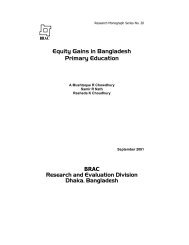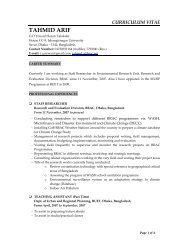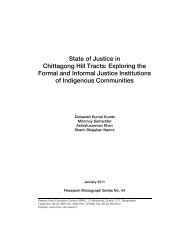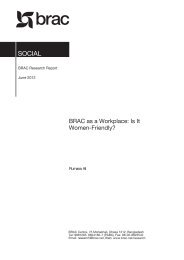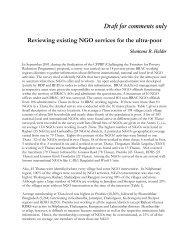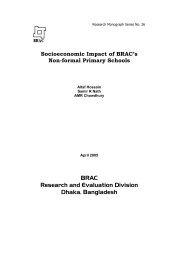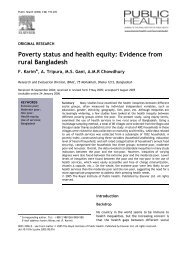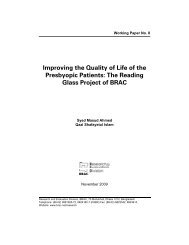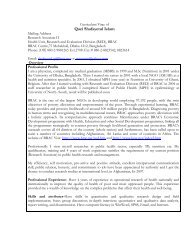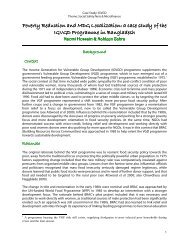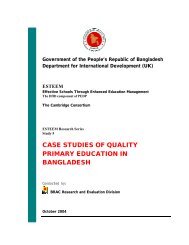Combining health and social protection measures to reach the ultra ...
Combining health and social protection measures to reach the ultra ...
Combining health and social protection measures to reach the ultra ...
You also want an ePaper? Increase the reach of your titles
YUMPU automatically turns print PDFs into web optimized ePapers that Google loves.
Innovation<br />
Towards <strong>the</strong> development of a<br />
Health Innovation Strategy for<br />
South Africa<br />
Article by Glaudina Loots<br />
South Africa is currently at a significant set of crossroads<br />
due <strong>to</strong> <strong>the</strong> great need for <strong>health</strong> innovation <strong>to</strong> combat<br />
<strong>the</strong> tremendous <strong>health</strong> challenges in our diverse<br />
society. The <strong>health</strong> needs should be addressed in such a way<br />
that <strong>the</strong> serious inequalities of our society at large are<br />
encompassed <strong>and</strong> negated. This means that <strong>the</strong> medication<br />
that is developed should be appropriate, accessible <strong>and</strong><br />
culturally acceptable <strong>to</strong> <strong>the</strong> population. This issue <strong>the</strong>n needs<br />
<strong>to</strong> take in<strong>to</strong> account various major challenges such as<br />
appropriate <strong>health</strong> medication, <strong>health</strong> infrastructure <strong>and</strong> also<br />
appropriate needs-oriented research. This article will give a<br />
broad <strong>and</strong> brief overview of <strong>the</strong> progress <strong>to</strong>wards <strong>the</strong><br />
establishment of a Health Innovation Strategy for South Africa<br />
from <strong>the</strong> perspective of <strong>the</strong> South African national government<br />
Department of Science <strong>and</strong> Technology.<br />
The meaning <strong>and</strong> need for a Health<br />
Innovation Strategy<br />
The continuous need for new drugs, vaccine <strong>and</strong> diagnostics<br />
<strong>and</strong> new processes in engineering <strong>and</strong> manufacturing, as well<br />
as new approaches <strong>to</strong> <strong>health</strong> systems <strong>and</strong> services within<br />
developing countries 1 is driving <strong>the</strong> need for <strong>the</strong> development<br />
of <strong>health</strong> innovation strategies. Within this context <strong>the</strong>re is a<br />
need for an overarching framework that can facilitate this<br />
process – this is where an appropriate Health Innovation<br />
Strategy fits in<strong>to</strong> <strong>the</strong> picture.<br />
An area of global concern is that only 10% of <strong>the</strong> global<br />
<strong>health</strong> research <strong>and</strong> development budget is being spent on<br />
90% of <strong>the</strong> global <strong>health</strong> problems 2 . This unequal flow of<br />
resources has since been referred <strong>to</strong> as <strong>the</strong> “10/90 gap”.<br />
Health in <strong>the</strong> developing countries is no longer <strong>the</strong> concern of<br />
<strong>the</strong> developed countries; however, <strong>the</strong>re is growing recognition<br />
internationally that <strong>the</strong> <strong>health</strong> of more than 80% of <strong>the</strong> world<br />
is a matter of concern <strong>to</strong> all who inhabit this world. One of <strong>the</strong><br />
crucial fac<strong>to</strong>rs responsible for this “10/90” gap is <strong>the</strong> lack of<br />
integration of <strong>health</strong> research in<strong>to</strong> national <strong>and</strong> international<br />
research systems.<br />
India, Brazil, China <strong>and</strong> South Africa are currently seen as<br />
<strong>the</strong> leading innovative developing countries. Of <strong>the</strong> four, South<br />
Africa’s Health Research <strong>and</strong> Development (R&D) budget<br />
as a percentage of public <strong>health</strong> expenditure is <strong>the</strong> lowest <strong>and</strong><br />
falls behind that of India <strong>and</strong> Brazil. For South Africa <strong>to</strong> be on<br />
par with <strong>the</strong> o<strong>the</strong>r three countries, a concerted effort needs <strong>to</strong><br />
be made <strong>to</strong> increase <strong>the</strong> government R&D expenditure.<br />
It is increasingly being recognized that <strong>health</strong> research exists<br />
within <strong>the</strong> broader context of research systems which, in turn,<br />
function within <strong>the</strong> specific socio-political <strong>and</strong> economic<br />
context of <strong>the</strong> relevant country 3 .<br />
Similarly, <strong>health</strong> innovation systems operate within a given<br />
country’s education, manufacturing, research <strong>and</strong><br />
development system – guided, naturally, by regula<strong>to</strong>ry<br />
systems, intellectual property policies <strong>and</strong> market forces,<br />
domestically <strong>and</strong> internationally.<br />
It is within this complex context that <strong>the</strong> South African<br />
government <strong>and</strong>, in particular, <strong>the</strong> Department of Science <strong>and</strong><br />
Technology, is engaged in establishing a national framework<br />
that will enable research, development <strong>and</strong> innovation.<br />
Research, development <strong>and</strong> innovation<br />
within <strong>the</strong> South African context<br />
The National Research <strong>and</strong> Development Strategy (2002) 4<br />
(NRDS) in South Africa was adopted by Parliament as a<br />
strategy geared <strong>to</strong>wards <strong>the</strong> establishment of <strong>the</strong> necessary<br />
enabling environment. The NRDS recognizes <strong>the</strong> complex<br />
interplay <strong>and</strong> <strong>the</strong> synergies that can be created through coordination<br />
between sec<strong>to</strong>r specific research systems <strong>and</strong> <strong>the</strong><br />
National System of Innovation that includes <strong>the</strong> universities,<br />
<strong>the</strong> various national science councils, government <strong>and</strong> <strong>the</strong><br />
private sec<strong>to</strong>r.<br />
The NRDS sees <strong>the</strong> Department of Science <strong>and</strong> Technology<br />
(DST) playing a strong role with regard <strong>to</strong> <strong>health</strong> research <strong>and</strong><br />
<strong>health</strong> technology in South Africa. Health-related research<br />
should soften <strong>the</strong> devastation caused by diseases.<br />
The NRDS recognizes that <strong>the</strong> following issues, although<br />
not exhaustive, should form <strong>the</strong> core of <strong>the</strong> <strong>health</strong> research<br />
effort:<br />
✜ Underst<strong>and</strong>ing <strong>the</strong> <strong>social</strong> impact of disease.<br />
✜ Creating an environment <strong>and</strong> technologies <strong>to</strong> reduce <strong>the</strong><br />
effect of poverty on <strong>the</strong> spread of disease.<br />
✜ Developing care <strong>and</strong> support strategies.<br />
✜ Underst<strong>and</strong>ing <strong>the</strong> challenges in providing access <strong>to</strong><br />
prevention <strong>and</strong> care <strong>measures</strong>.<br />
✜ Developing innovative preventative strategies.<br />
✜ Developing novel <strong>the</strong>rapeutic regimes, including <strong>the</strong><br />
utilization of indigenous knowledge.<br />
✜ Developing preventive <strong>and</strong> <strong>the</strong>rapeutic HIV/AIDS vaccines.<br />
076 ✜ Global Forum Update on Research for Health Volume 4



